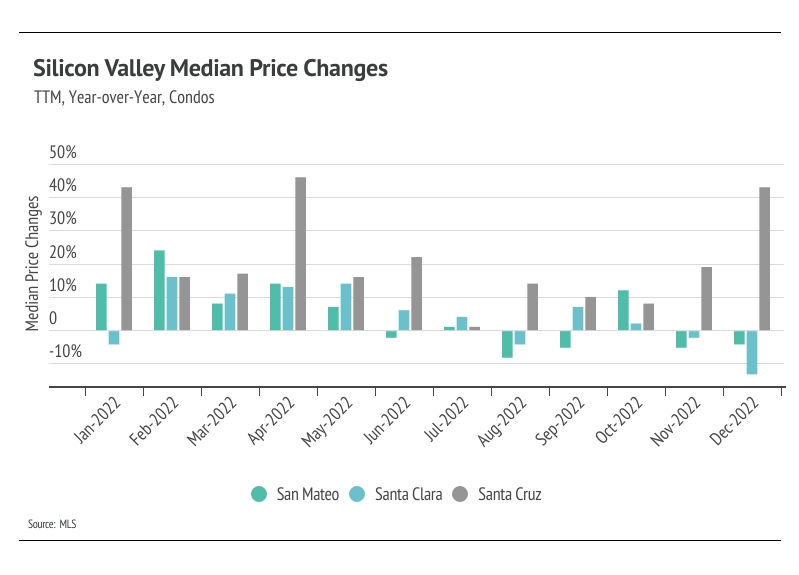Note: You can find the charts/graphs for the Local Lowdown at the end of this section.
New year, old normal
As we mentioned in the Big Story, the market has cooled for both buyers and sellers, largely because of higher interest rates. As we enter the new year, the market feels familiar — but from the era before 2020. Demand in Silicon Valley is evergreen, so we aren’t worried about matching buyers and sellers. That said, sellers likely won’t be getting multiple offers the second the home hits the market again anytime soon. To make a long story short, there is definitely less stress on the buying side of the market. Prices will most likely increase in 2023, but at a more modest rate of around 5-6%, which makes for a much healthier market than what occurred over the past three years. Single-family home and condo prices increased over the past two years, even with the declines from the peaks reached in 2022. Without any signs of interest rates dropping, we’re entering a stage of slower, longer-term growth.
More new listings should come to the market in the first quarter
When we look at single-family home inventory levels for 2021 and 2022 side by side, it’s immediately apparent that inventory levels in any given month were fairly similar, but the markets were quite different. The 2021 market was defined by the high demand and high number of new listings, which helped drive a huge number of sales. New listings and sales rose and fell in tandem, but sales significantly outpaced new listings at the end of 2021, which dropped inventory to an all-time low. In 2022, however, far fewer listings came to market, especially in the second half of the year. Fewer homes and the rising rate environment dropped demand, bringing the market closer to balanced between buyers and sellers, but the sharp decline in new listings and steady sales reversed that trend in November and December. The condo market had a simpler story in that fewer new listings came to market without a proportional decline in sales, so inventory remained low and reached an all-time low in December 2022. This year, we expect the housing market to look a lot more like 2022 than 2021.
Months of Supply Inventory implies a sellers’ market
Months of Supply Inventory (MSI) quantifies the supply/demand relationship by measuring how many months it would take for all current homes listed on the market to sell at the current rate of sales. The long-term average MSI is around three months in California, which indicates a balanced market. An MSI lower than three indicates that there are more buyers than sellers on the market (meaning it’s a sellers’ market), while a higher MSI indicates there are more sellers than buyers (meaning it’s a buyers’ market). MSI has trended higher since spring 2022 but leveled out around two months of supply before reversing, indicating Silicon Valley is still in a sellers’ market. Despite the changing economic environment, we are comfortable saying that the market will still favor sellers for at least the first quarter of 2023.
Local Lowdown Data










Our team is committed to continuing to serve all your real estate needs while incorporating safety protocol to protect all of our loved ones.
In addition, as your local real estate experts, we feel it’s our duty to give you, our valued client, all the information you need to better understand our local real estate market. Whether you’re buying or selling, we want to make sure you have the best, most pertinent information, so we put together this monthly analysis breaking down specifics about the market.
As we all navigate this together, please don’t hesitate to
reach out to us with any questions or concerns. We’re here to support you.







